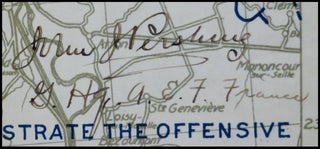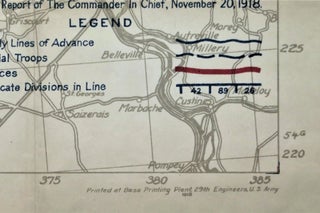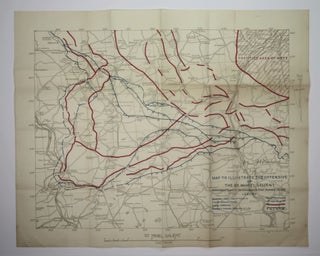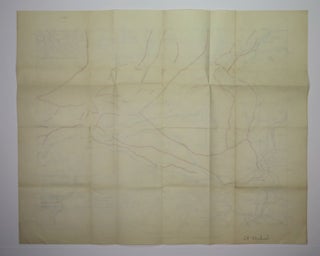Map to Illustrate of the Offensive of the St. Mihiel Salient to Accompany Report of the Commander In Chief, November 20, 1918, signed in France by the battle's victorious Allied commander and leader of the American Expeditionary Force, General John J. Pershing
France: Printed at Base Printing Plant, 29th Engineers, U.S. Army, 1918. Map. This extraordinary map of the First World War’s first U.S.-led offensive was signed in the field by the man who commanded the victory – General John J. Pershing.
“Printed at Base Printing Plant, 29th Engineers, U.S. Army 1918”, this map is titled “MAP TO ILLUSTRATE THE OFFENSIVE OF THE ST. MIHIEL SALIENT To Accompany Report of The Commander In Chief, November 20, 1918”. Just above the title and legend the map is signed in two lines in black ink “John J. Pershing | G. Hq. A.E.F. France”.
Examples of this map reside in the Library of Congress and the National Museum of the World War, but this is the only copy we find signed thus. Pershing’s signature on the war-map of a battlefront when and where he affected the fate and borders of nations viscerally tethers this artifact to the history it documents.
The map measures 24.5 x 19.625 inches (62.2 x 49.8 cm). It is printed at 1:100,000 scale in blue, red, and gray illustrating “American Daily Lines of Advance” and “French Colonial Troops” as well as “Enemy Defences” with numbers that “Indicate Divisions in Line”. Condition is very good, complete with only mild age-toning. Crease wear primarily attributes to having long been neatly folded.
The Battle of Saint-Mihiel, which took place in mid-September 1918, was an Allied victory and the first U.S.-led offensive of the First World War. The town of Saint-Mihiel is in northeastern France on the right bank of the Meuse River 22 miles (35 km) south-southeast of Verdun. Like many towns in western Europe in the first half of the twentieth century, its name became widely known not for any attribute of its native soil, but rather for the blood spilled thereon.
The career of John J. Pershing (1860-1948) spanned such varied milieu as pursuing Pancho Villa at the Texas-Mexican border and leading Allied and U.S. forces in European trench warfare. In April 1917 the U.S. declared war on Germany and President Woodrow Wilson appointed Pershing to command the American Expeditionary Force (AEF). In mid-September 1917, Pershing led AEF and French troops, recapturing territory that had been held by the Germans for three years. “American confidence soared. Allies carped at the amateurish organization and procedures, but veteran German observers were dismayed by the fresh valor of Pershing’s men.” (ANB).
Despite battlefield success, Pershing’s offensive tactics were not without some censure. Pershing heavily relied on frontal assaults, a tactic the French, British, and Germans had learned were not efficacious in modern trench warfare. Consequently, Pershing was harshly criticized for accruing unnecessary casualties, and some attributed the success of the offensive more to German fatigue and attrition than to Pershing’s acumen. Apprised of the imminent American offensive, German General Erich Von Ludendorff had already begun to withdraw his troops before the American attack to a more defensible position nearer the fortified area of Metz—denoted on this map with thin red lines.
“Modest, businesslike, and serious,” Pershing “charmed and impressed everyone.” By war’s end, despite America’s late entry and comparative inexperience, Pershing’s command was credited with “courage, ingenuity, and perseverance that made the difference in 1918.” Sailing home from France in September 1919, Pershing received word of his promotion to general of the armies – a rank previously held only by George Washington. As post-WWI army chief of staff, “Pershing concentrated on… maintaining the efficiency of the officer corps by keeping an eye on such rising stars as George Marshall, George Patton, Dwight Eisenhower, and a small cadre of possible future leaders known as ‘Pershing’s Men.’” Pershing’s offer of service to President Roosevelt was graciously refused when the U.S. entered the Second World War, but he made one last vital contribution; “Roosevelt listened when Pershing… urged George Marshall as the only man capable of being chief of staff in a two-front war.”. Item #006081
Price: $4,000.00






